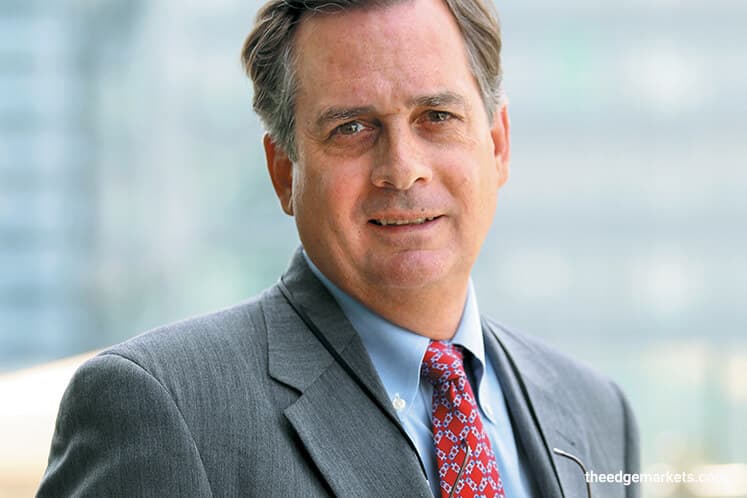
This article first appeared in Personal Wealth, The Edge Malaysia Weekly on June 12, 2017 - June 18, 2017
Now is the time for investors to employ hedging strategies for their bond portfolios as a rate hike cycle in developed markets is imminent, says Brooks Ritchey, senior managing director and head of portfolio construction at K2 Advisors.
He says developed markets such as the US, the UK and the European Union could be embarking on an interest rate hike cycle this year. “The market is anticipating the US Federal Reserve to raise rates in June. The European Central Bank has held its rate steady [at 0% in March], but there has been talk that it may reduce its quantitative easing programme. The Bank of England has also signalled that it could raise rates going forward.
“A rate hike cycle in developed markets could lead to changes in bond prices and foreign currencies, which could create wider spreads in the markets. This will benefit hedge funds and those with hedging strategies,” says Ritchey.
K2 Advisors, which is part of Franklin Templeton Investments, provides hedge fund products to institutional and retail investors. Besides managing investors’ money internally, the firm also allocates part of its clients’ investments to other hedge fund managers who utilise different hedging strategies.
Looking at the historical data, it is natural for interest rates to start rising soon, says Ritchey. “For instance, the US interest rate has been coming down in the past 30 to 35 years. It finally hit a low in 2012. It started to stabilise after that and now, it may be moving higher. Investors could finally see a more significant shift in the interest rate cycle.”
Ritchey, who is senior vice-president and director of investment solutions at Franklin Templeton Solutions, says some fund managers K2 Advisors is working with have started to take short positions on developed market government bonds and going long on developed market high-yield bonds.
That is because fund managers foresee the yield spread between developed markets sovereign bonds and high-yield bonds tightening. Sovereign bond prices are expected to go down while yields go up as investors reallocate their money to newly issued bonds with higher rates or park it in fixed deposits at banks.
At the same time, developed market high-yield bond prices are expected to go up as yields fall. This is due to the improvement in the profits of corporates on the back of the recovering economies of these developed countries (which is reflected in the increase in interest rate).
While some companies with high debt levels will be negatively impacted by higher interest rates, some companies will benefit from it as economic growth improves and rates rise, says Ritchey. “These are companies with high cash levels or low debt levels.”
This wider spread scenario happened in the second half of last year and could happen again, he says. “On June 30 last year, the 10-year US Treasury notes were at 1.47% while the yield of the Bloomberg Barclays US Corporate High Yield Bond Index was 7.27%, according to Bloomberg,
“Over the next six months, the price of 10-year US Treasury notes declined as yields rose 0.98% to close at 2.45%. During the same period, high-yield bonds [appreciated while] the yield declined 1.15% as the bonds rallied strongly to close the year with a yield of 6.12%.”
Ritchey says taking a short position on government bonds and long position on high-yield bonds will allow fund managers to reap returns from movements on both sides. “In a perfect scenario, we will be able to earn from both. Another scenario is we might lose some money on one side, but earn more on the other side [as both sides tend to be negatively correlated].”
Ritchey says there is a risk that both sides of the bet go wrong. But ultimately, the volatility of the investment portfolio should be much lower than simply taking a long or short position.
Fees going down
Investors are concerned that the high fees charged by hedge fund managers will eat into their returns. These fund houses usually charge a 2% management fee and 20% performance fee.
In March, Warren Buffett criticised hedge fund managers saying that they do not add value for their investors due to the high fees. “If you go to a dentist, if you hire a plumber, in all these professions, there is value added by the professionals as a group compared with doing it yourself or just randomly picking laymen,” he says.
“In the investment world, it is not true. The active group (referring to hedge fund managers) in aggregate, the people who are professionals, cannot do better than the aggregate of those who just sit tight.”
Ritchey says K2 Advisors is “standing on the same side as Warren Buffett” as the firm managed institutional and retail investors’ funds by allocating them to hedge fund managers. He also says fees charged by hedge funds have declined over the years.
“We want the fees to be low. In fact, with respect to our registered liquid alternatives funds, we have been able to get fund managers to manage the assets for us by charging a flat fee of 1%. They do not take any performance fees,” says Ritchey.
“This is the new hedge fund environment as everybody wants fees to go down. This is important for us and the investors.”
On top of that, the money invested in K2's registered liquid alternatives funds can be redeemed by investors on a daily basis.
Save by subscribing to us for your print and/or digital copy.
P/S: The Edge is also available on Apple's AppStore and Androids' Google Play.